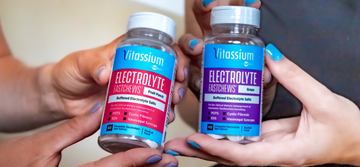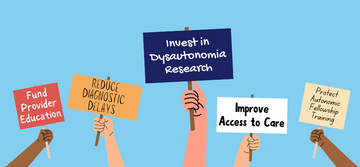
“My journey with EDS has been an enriching journey, a long journey, and a times a very hard journey, but a journey I probably wouldn’t change.” — Lara Bloom, president, founder and CEO of the Ehlers-Danlos Society
The Ehlers-Danlos syndromes (EDS) are a group of connective tissue disorders generally characterized by joint hypermobility (joints that stretch further than normal), skin hyperextensibility (skin that can be stretched further than normal), and tissue fragility. Commonly, people living with EDS can experience joint pain, early onset of osteoarthritis, skin that tears or bruises easily and severe scarring. Importantly, each person’s experience with an EDS is their own and may not necessarily be the same as another person’s experience.
According to the Ehlers-Danlos Society, research statistics show the total prevalence of EDS as one in 2,500 to one in 5,000 people; however, recent clinical experience suggests the syndromes may be more common. While there is no cure for the Ehlers-Danlos syndromes, there are treatments for symptoms and preventative measures that most people find helpful.
For example, people living with EDS can experience other, additional conditions, including postural orthostatic tachycardia syndrome (POTS), which is characterized by excessive increases in heart rate upon sitting or standing up. According to the Johns Hopkins Institute of Genetic Medicine, POTS symptoms can be alleviated by maximizing blood volume through increased intake of water and salt. SaltStick Vitassium is a medical food specifically formulated to provide sodium and potassium for the clinical dietary management POTS, EDS, Cystic Fibrosis (CF), and Vasovagal Syncope, when increased plasma volume has been shown to be beneficial. Many people living with these conditions have found SaltStick Vitassium a useful tool to help manage their symptoms. You can learn more about the science behind Vitassium here.
Our conversation with Lara Bloom, president, founder and CEO of the Ehlers-Danlos Society
The Ehlers-Danlos Society is a global community of individuals, caregivers, healthcare professionals, and supporters, dedicated to saving and improving the lives of those affected by EDS, hypermobility spectrum disorders (HSD), and related conditions. Lara Bloom, president, founder and CEO of the Ehlers-Danlos Society, recently spoke with us about her experience living with EDS, as well as what she and her organization are doing to raise awareness and funding for research into the global progression of EDS and HSD.
Below you can find a summary of our conversation.
Tell us about your journey with EDS.
I went through the typical diagnosis odyssey that most people experience with EDS. I was symptomatic from the age of 11, but had a hard time getting people to believe me and was often told I was a hypochondriac. I didn’t receive a diagnosis until I was 24, and in the meantime, my health deteriorated quite massively.
Eventually, I was lucky to be diagnosed correctly, which allowed me to find a treatment plan that has since help turn things around, although not without significant costs. I used to be a photographer but had to change careers as a result of my condition. That’s how I got started in the patient advocacy space (Prior to founding the Ehlers-Danlos Society, Lara ran EDS UK from 2010-2015).
But it’s all worked out in the end. My journey with EDS has been an enriching journey, a long journey, and a times a very hard journey, but a journey I probably wouldn’t change.
As with any “invisible condition,” EDS patients often must battle the notion they are making things up. What other aspects of the condition do you think are broadly misunderstood?
That’s indeed one of the biggest challenges, both from medical professionals and friends and family. EDS can be so sporadic; one day you can be absolutely fine and the next day you can’t even lift your own head. That can be very hard to understand.
But I think a broader issue is the lack of access to anything that can make a person’s EDS better. Receiving an accurate diagnosis is the first hurdle, as the average wait to diagnosis is approximately 12 years. But once a person receives their diagnosis, they face an even bigger challenge to find appropriate care and management. As a result, people can suffer from deconditioning, which often means they could end up in a wheelchair, which could have been prevented with the right treatment plan. Some people’s lives are improved so much from using a chair, and that is a very positive thing, but if that could have been avoided from appropriate care and early diagnosis then that would be great. Ultimately, people aren’t being given a chance to live a good quality of life.
What motivated you found the Ehlers-Danlos Society?
During my time as head of EDS UK, it became clear that while national patient organizations are doing great work and an essential part of everyday care, there was a broad desire to tackle challenges both globally and collaboratively. At the time, there was no organization in place that had the funds and capacity to commit to that.
I left EDS UK in 2015 to think about the best path forward, and ultimately, helped launch the Ehlers-Danlos Society in May 2016 as a global organization designed to address these gaps.
When you look back at what you’ve been able to accomplish in your current role as CEO of the Ehlers-Danlos Society, what are you most proud of?
Speaking personally, as well as from the perspective of the Society, I think our biggest accomplishment has been bringing together the global professional and patient community. Previously, these spaces were so fragmented, and people weren’t working together. I’m reminded of an African proverb that says, “If you want to go fast, go alone, if you want to far go together.”
We’ve seen the wisdom in those words come to life every day with the work we’re doing. We have accomplished more in the last few years than has ever been accomplished with this condition, and it is because everyone is working together. Historically, there was no real collaborative research taking place, and there were no grants available for funding. Even though plenty of people in the research and academic community wanted to research EDS, they didn’t have anywhere to turn.
When we set up our organization, our biggest priority was—and continues to be—research, and since we’ve launched, we’ve given $3.5 million towards research efforts. One notable project is the HEDGE Study, the most comprehensive, collaborative effort to date in seeking to understand the underlying genetic causes of hypermobile Ehlers-Danlos syndrome. Beyond that, the money we’ve been able to give in grants has increased dramatically each year since our launch, and we’re now working with researchers all over the world.
What do you consider to be the biggest challenge you’re facing?
I think it’s got to come down to funding. I’m thrilled we have raised several million dollars in the last year, but actually it’s a drop in the ocean when you compare it with other conditions. Part of the issue is continued lack of awareness of EDS and its related conditions, so when someone has the opportunity to donate to a health-related cause, they’re much more likely to reach out to an organization that is tackling cancer or heart disease.
That said, I’m optimistic for the future, especially now that we have several projects underway, such as our global registry, which I expect will help us prove how many people are living with EDS. Once we are able to convey the economic costs of these conditions to the health care system, I’m hoping we can continue to improve the diagnostic and treatment hurdles people face.
On the flip side, what excites you most about the next 10 years?
Oh, I mean there’s so many! I’m really excited about EDS ECHO, an educational and mentoring platform for health care providers that launched last year. Already, we’re well on track to meet our growth goals. I’m also excited about our global registry, which I mentioned earlier. We have around 9,000 people right now from all over the world, but we need hundreds of thousands. Anecdotally, we know there are so many people living out there with EDS or a related condition, but we’re missing the evidence to show the true scale of this condition.
We’re also continuing to grow as an organization, increasing the number of conferences and countries we can engage in. A year and a half ago, we had a three-member staff, and now we have 20. It feels like we’re expanding by the hour. That’s a wonderful thing, but I think a goal for us now is to settle into what we are doing so we can continue to grow in a sustainable way. That’s going to continue to help us keep improving the lives of people in our community.







